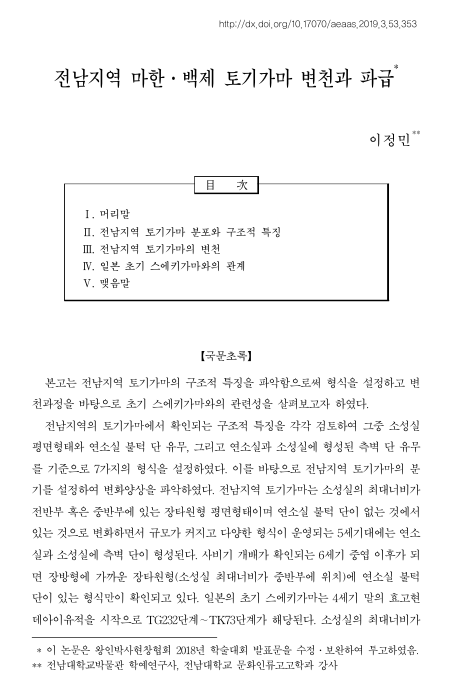이정민 2019,〈전남지역 마한·백제 토기가마 변천과 파급〉,《동아시아고대학》제53집, 동아시아고대학회. ((사)왕인박사현창협회 2018년 학술대회 ‘고대 호남-큐슈지역의 교류와 왕인박사’ 발표문)

본고는 전남지역 토기가마의 구조적 특징을 파악함으로써 형식을 설정하고 변천과정을 바탕으로 초기 스에키가마와의 관련성을 살펴보고자 하였다. 전남지역의 토기가마에서 확인되는 구조적 특징을 각각 검토하여 그중 소성실 평면형태와 연소실 불턱 단 유무, 그리고 연소실과 소성실에 형성된 측벽 단 유무를 기준으로 7가지의 형식을 설정하였다. 이를 바탕으로 전남지역 토기가마의 분기를 설정하여 변화양상을 파악하였다. 전남지역 토기가마는 소성실의 최대너비가 전반부 혹은 중반부에 있는 장타원형 평면형태이며 연소실 불턱 단이 없는 것에서 있는 것으로 변화하면서 규모가 커지고 다양한 형식이 운영되는 5세기대에는 연소실과 소성실에 측벽 단이 형성된다. 사비기 개배가 확인되는 6세기 중엽 이후가 되면 장방형에 가까운 장타원형(소성실 최대너비가 중반부에 위치)에 연소실 불턱 단이 있는 형식만이 확인되고 있다. 일본의 초기 스에키가마는 4세기 말의 효고현 데아이유적을 시작으로 TG232단계∼TK73단계가 해당된다. 소성실의 최대너비가 중반부에 있는 장타원형 평면형태이며 연소실 불턱 단이 있는 것과 없는 것이 혼재되어 있다. 전남지역 토기가마와 초기 스에키가마의 구조는 소성실 평면형태 및 연소실 불턱 단 유무의 혼재 등 공통점을 띤다. 또한 3∼4세기대의 각 지역별 소규모 조업, 5세기 전․중반의 특정지역 중심 조업, 5세기 후반에 대규모 생산체제 및 지방 내에서의 조업이 증가되는 등 확산 과정에서도 유사성을 보인다. 가마의 구조적 속성뿐 아니라 사회․문화적 양상이 바탕이 되는 확산 과정에서의 관련성으로 보아 고대 전남지역과 일본과의 교류가 긴밀했음을 추정해 볼 수 있다.
The purpose of this study is to examine the structural characteris tics of pottery kilns in Chonnam area and to examine the relationship between them and the early Sueki kiln based on the process of change. The structural characteristics of the pottery kiln in Chonnam area were examined. Seven types of structural features were established based on the shape of firing chamber, the presence of stepped structure of combustion chamber, and the existence of the stepped structure at the side wall formed in the combustion chamber and firing chamber. Based on this, set up branch of pottery kiln in Chonnam area and figure out the change pattern. The pottery kiln in Chonnam area has the largest width of the firing chamber in the first half or the middle half, and it has a flat oval shape and no existence of stepped structure of combustion chamber. In the 5th century, stepped structure exists between combustion chamber and firing chamber. After the middle of the 6th century, when the Gaebe(serving vessel) of Sabi period was discovered, only the type with stepped structure of combustion chamber is the long elliptical shape (the maximum width of the firing chamber is in the middle) near the rectangular shape is confirmed. The early sueki kilns of Japan, the TG232 step ∼ TK73 step corresponds to the start of the fourth century at Deai site in Hyogo. The maximum width of the firing chamber is the long elliptical flat oval shape with the middle half, and the combustion chamber has a mixed wedge with and without. The structure of the pottery kiln and the early sueki kiln in Chonnam area has a common point such as the combination of shape of the firing chamber and the presence or absence of stepped structure of combustion chamber. It also shows similarities in the proliferation process, such as small-scale operations in each region in the 3rd and 4th centuries, specific regional operations in the mid-5th century, large-scale production in the late 5th century, and increased operations within the province. It can be assumed that the relation ship between ancient Chonnam area and Japan is close to each other in view of the relationship between the structure of the kiln and the diffusion process that is based on the social and cultural aspects.


의견쓰기
0 개의 의견이 있습니다.